Interctive Approach
Download as pptx, pdf0 likes613 views
The document summarizes the origins and development of research on interaction and second language learning. Early studies examined modifications in native speaker (NS) input to non-native speakers (NNS) and differences between baby talk and foreigner talk. Later research found NS modifications could negatively impact NNS participation and argued NNS-NNS interactions provide more opportunities for negotiation of meaning. Additional studies explored the importance of learner output in interaction and comprehensible output for second language acquisition.
1 of 9
Download to read offline
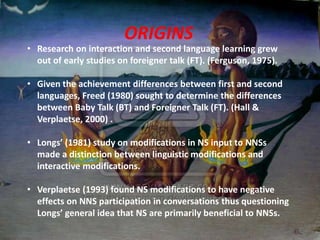
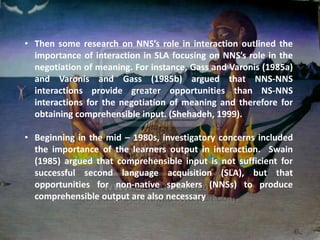
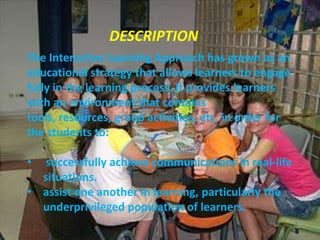
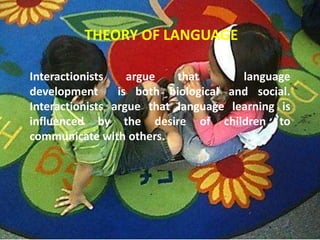
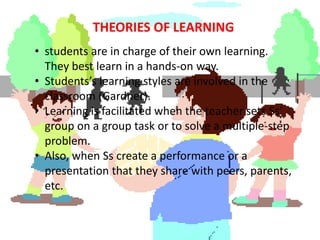
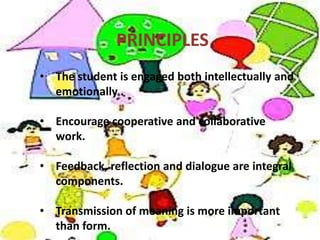


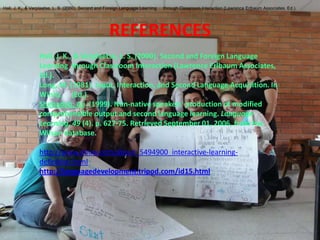
Ad
Recommended
Input, interaction, and output in sla
Input, interaction, and output in slaYayasan Pemuda Mitra Masyarakat Desa
╠²
This document discusses input, interaction, and output in second language acquisition. It defines input as the language a learner is exposed to, interaction as the conversations learners participate in which allow them to receive feedback, and output as language production which can help learners develop grammar. The document also examines feedback, both explicit and implicit, negotiation of meaning between interlocutors, and the role of attention in intake from input. It notes common misunderstandings of the interaction approach and debates regarding explicit versus implicit learning.Input and Interaction--Group 10 SLA
Input and Interaction--Group 10 SLA Lambung Mangkurat University
╠²
1) The document discusses input and interaction in second language acquisition. It defines input as the language directed at the non-native speaker through listening and reading. Input must be comprehensible and slightly above the learner's level.
2) The document also examines Stephen Krashen's Input Hypothesis which posits that language is acquired through comprehensible input that is one stage above the learner's current ability.
3) Interaction involves face-to-face communication between language learners and promotes language development through receiving feedback and negotiating meaning.Input -interaction--and-output (5)
Input -interaction--and-output (5)Elif G├╝ll├╝budak
╠²
The document discusses various types of language input provided to language learners, including comprehensible input containing linguistic items slightly beyond the learner's competence, and modified input using simplifications to aid comprehension. It also examines interaction and feedback, noting the interaction hypothesis that language acquisition benefits from negotiation of meaning during communication breakdowns and the various forms feedback can take, such as recasts, clarification requests, and explicit correction.Input, interaction, foeigner and teacher talk
Input, interaction, foeigner and teacher talkdamarisescobar1911
╠²
The document discusses input, interaction, teacher talk, and foreigner talk in second language acquisition. It summarizes theories that comprehensible input and interaction are important for acquisition. Teacher talk is simplified language used by teachers to aid comprehension, while foreigner talk refers to modifications native speakers make when addressing non-native speakers. Both teacher talk and foreigner talk aim to facilitate understanding through simplification and other adjustments based on the listener's language level.Interaction and second language acquisition: an ecological perspective
Interaction and second language acquisition: an ecological perspectiveVera Menezes
╠²
This document discusses interaction and second language acquisition from an ecological perspective. It argues that interaction is essential for language acquisition, as humans have an innate drive to socially interact. While classroom interaction is important, experiences outside the classroom through interaction in natural environments and mediated interactions enabled by technology can also greatly contribute to second language acquisition. The conclusion advocates for teachers to help students broaden their opportunities for interaction beyond the classroom to explore new linguistic worlds.Group 4 role of l2 input
Group 4 role of l2 inputPhun Bandith
╠²
The document discusses the role of input in second language acquisition from several perspectives. It defines input as the language directed at the learner, and notes that it can be conscious or unconscious. Input comes in written, verbal, and non-linguistic forms from teachers, students, and media. The input hypothesis states that language is acquired through comprehending messages. Teachers should provide comprehensible input that is interesting, sufficient, and authentic to improve students' knowledge.Presentaci├│n2.ppt input and interaction
Presentaci├│n2.ppt input and interactionJoel Acosta
╠²
The document discusses the role of input and interaction in second language acquisition (SLA), highlighting Stephen Krashen's input hypothesis, which emphasizes the importance of comprehensible input for effective language learning. It also explores the significance of interaction in the learning process, positing that communication aids language development by fostering negotiation of meaning and providing feedback. Additionally, the document addresses concepts like teacher talk, foreigner talk, and error analysis in the context of language education.Input and Interaction in second language learning
Input and Interaction in second language learningMahsa Farahanynia
╠²
The document discusses the importance of input and interaction in second language (L2) learning, defining input as the exposure to the target language and highlighting its elements of availability and accessibility. It reviews various theories of second language acquisition (SLA) regarding the role of input, including behaviorism, mentalism, and interactionism, ultimately emphasizing that interaction and comprehensible output also play crucial roles in the learning process. The document also outlines different types of input and interaction in classroom settings, suggesting that both form-focused instruction and task-based language teaching can enhance language acquisition.Negotiation for meaning theory
Negotiation for meaning theoryFaby1705
╠²
Negotiation of meaning involves interactions between speakers to achieve mutual understanding. It is a key process in second language acquisition, as it provides comprehensible input through modifications and adjustments during interaction. Research has found that classroom activities that encourage negotiation of meaning, such as information gap tasks, provide greater benefits to learners' development of communicative competence.Input and SLA
Input and SLACarlos Mayora
╠²
The document discusses the types of input encountered while learning a foreign language, highlighting the importance of exposure through various mediums such as oral, written, and multimodal formats. It explains the characteristics and differences between authentic and modified inputs, along with the concepts of comprehensible input, apperceived input, and intake. Finally, it stresses the necessity for attention in the learning process and provides references for further reading on second language acquisition.Input and Interaction - Psychology of Language Learning
Input and Interaction - Psychology of Language LearningRichard Gallahad
╠²
This document covers several key topics in second language acquisition (SLA) research including Krashen's input hypothesis, Long's interaction hypothesis, Chomsky's views on language acquisition, Krashen's acquisition/learning hypothesis, the affective filter hypothesis, comprehensible input, the natural order hypothesis, issues with Krashen's thinking, negotiation of meaning, and generalizations from SLA research. It provides explanations of these concepts and cites supporting research from scholars like Ellis, Krashen, Lightbown, Spada, and VanPatten. Modified Input (Foreigner Talk)
Modified Input (Foreigner Talk)Sawsan Ali
╠²
This document discusses foreigner talk (FT), which is a modified style of speech that native speakers use when talking to non-native speakers. It defines FT and discusses various types of modifications made in FT, including grammatical and ungrammatical modifications, interactional modifications, and functions of FT. Grammatical FT involves simplification, regularization, and elaboration of language. Ungrammatical FT includes omissions and changes to grammar, vocabulary, and pronunciation. FT aims to facilitate communication and language learning for non-native speakers. Examples of FT in conversations are provided to illustrate modifications.Interaction hypothesis
Interaction hypothesisJohnRegatto
╠²
The interaction hypothesis proposes that comprehensible input and negotiation for meaning during face-to-face interaction contributes to second language acquisition. There are two forms of the hypothesis: one that emphasizes comprehensible input and another that suggests interactions provide negative evidence and focus learner attention. While interaction may aid language learning, it is not absolutely necessary, and its role is complex as interactions are not always positive.Interaction hypothesis by Atula Ahuja
Interaction hypothesis by Atula AhujaAtula Ahuja
╠²
Michael Long developed the Interaction Hypothesis in 1983, which posited that comprehensible input alone is not sufficient for second language acquisition. The hypothesis emphasizes that meaningful interaction and negotiation of meaning between interlocutors is essential. When learners do not understand, interaction provides opportunities to modify input through techniques like clarification requests and confirmation checks. This negotiated interaction allows learners to notice gaps and facilitates acquisition by connecting input, internal processes, and output. Long later incorporated aspects of Merrill Swain's Output Hypothesis by acknowledging the role of output in development.Input vs output hypothesis
Input vs output hypothesischiamb
╠²
This document summarizes Krashen's input hypothesis and Swain's output hypothesis. The input hypothesis states that language acquisition occurs when learners understand language that is just beyond their current level. The output hypothesis argues that producing language through speaking and writing also contributes to acquisition by pushing learners to focus on expression. Both hypotheses complement each other, and a supportive learning environment, feedback, and engaging materials further help acquisition.Input and Interaction
Input and InteractionDigiTEFL
╠²
The document discusses several key concepts in second language acquisition (SLA) theory, including Krashen's input hypothesis, Long's interaction hypothesis, Chomsky's views on language acquisition, and Krashen's acquisition/learning hypothesis. It also examines notions of comprehensible input, the affective filter hypothesis, the monitor hypothesis, interlanguage, and negotiation of meaning. Generalizations from SLA research are presented regarding how adults and children acquire a second language in systematic ways through practice, but not in a way that achieves full native-like mastery.Interactional hypothesis
Interactional hypothesisPiseth Chea
╠²
The document discusses Michael Long's interactional hypothesis, which is based on Stephen Krashen's input hypothesis. The interactional hypothesis proposes that negotiated interaction between learners and their interlocutors can qualitatively change the nature of the input, facilitating language acquisition. When communication breaks down, interlocutors provide modified input through repetition, confirmation checks, comprehension checks, and clarification requests to aid comprehension. While interaction can help comprehension, it is not solely responsible for acquisition and individual differences are also important factors. The interactional hypothesis perspective has limitations but provides insights applicable for language teaching.Input, interaction, and second language acquisition
Input, interaction, and second language acquisitionPe Tii
╠²
The document discusses input, interaction, and second language acquisition from multiple perspectives. It begins by defining input and noting three views on input in language acquisition: behaviourist, nativist, and interactionist. It then examines foreigner talk studies, discourse analysis, and input/interaction in classroom settings. Research on motherese and first language acquisition is also summarized. The document provides an overview of different frameworks for analyzing classroom interaction, including interaction analysis, classroom process research, and teacher talk analyses.Negotiating Meaning
Negotiating MeaningCandice Marshall
╠²
This document discusses strategies for negotiating meaning and resolving misunderstandings when communicating, including avoidance strategies like topic avoidance and message abandonment, as well as achievement strategies such as paraphrasing through approximation, word coinage, or circumlocution. It also outlines methods for requesting clarification like asking the speaker to repeat or slow down if a question was misunderstood. Common sources of miscommunication mentioned include lack of background knowledge, vocabulary, or misunderstanding the question.Comprehensible output hypothesis
Comprehensible output hypothesisRoger Flores
╠²
The comprehensible output hypothesis was developed by Merrill Swain and states that language learning occurs when learners attempt to produce output and encounter gaps in their linguistic knowledge. This causes learners to modify their output as they learn. There are three functions of output: the noticing function where learners become aware of gaps, the hypothesis-testing function where learners test hypotheses through trial and error, and the metalinguistic function where learners reflect on and internalize language. The hypothesis argues that producing language, receiving feedback, and modifying output based on feedback helps learners acquire a second language.Describing input & its impact
Describing input & its impactMelia Sari
╠²
This document summarizes a lecture about describing language input and assessing its impact on second language acquisition. It discusses various types of input including written, verbal, and non-linguistic input. Key concepts covered include Krashen's input hypothesis, the role of comprehensible input, types of input outside the classroom like motherese and foreigner talk, and the role of negotiation and interaction in facilitating language acquisition.Instructed second-language-learning6666
Instructed second-language-learning6666Elif G├╝ll├╝budak
╠²
This document discusses different settings for second language learning, including natural acquisition settings, structured-based instructional settings, and communicative instructional settings. It outlines key differences in how language is presented and practiced in each setting. The document also discusses factors that influence language learning like teaching methods, language input, authentic vs non-authentic language examples, and the balance between complexity, accuracy and fluency in the classroom.ŃĆÉBook PresentationŃĆæEllis and shintani (2014). chapter 1 (JACET Reading Resear...
ŃĆÉBook PresentationŃĆæEllis and shintani (2014). chapter 1 (JACET Reading Resear...Yu Kanazawa / Osaka University
╠²
The document provides an extensive exploration of second language acquisition (SLA) research and its implications for language pedagogy. It covers key topics such as behaviorist and mentalist approaches, interlanguage theory, the role of input and output, consciousness in learning, and social perspectives on SLA. Furthermore, it outlines principles for effective language instruction, emphasizing a balance between implicit and explicit knowledge, engagement with comprehensible input, and consideration of individual learner differences.Linguistic environment
Linguistic environmentTony Kazanjian
╠²
The document discusses the role of the linguistic environment in second language acquisition. It covers 5 key ingredients: attitude, input, interaction, output, and noticing. Input alone may not be enough for acquisition and learners need opportunities for output and interaction. Noticing gaps in their language is important for learning. The environment can provide positive evidence, negative evidence, and opportunities for negotiation of meaning to aid acquisition, but individual and social factors also influence the learning process.Interactionist approach (mobin bozorgi)
Interactionist approach (mobin bozorgi)Mobin Bozorgi
╠²
The document discusses three major theories of language acquisition: behaviorism, innativism, and interactionism, focusing on Vygotsky's socio-cultural theory which posits that interaction with more advanced speakers enhances language proficiency. Long's interaction hypothesis asserts that comprehension and modified input through conversation are crucial for language acquisition, allowing learners to notice gaps in their knowledge and receive feedback. The interactionist approach emphasizes the role of interaction in promoting communication and learning, providing direct and indirect feedback that aids vocabulary acquisition.Second language acquisition!
Second language acquisition!Irina Payares
╠²
No, when I am 12.
S: I goed to the store.
T: No, you didn't goed to the store. The past tense of go is went. You went to the store.
S: She run fast.
T: No, the correct form is "She runs fast" or "She ran fast", depending on whether you're talking about the present or past tense.
S: I eated the food.
T: No, the past tense of eat is ate. You should say "I ate the food."
Explicit correction is direct and unambiguous.
REPETITION
Teacher repeats the correct form after the student's
incorrect utteranceNoticing
NoticingRitha Th├żn
╠²
The document discusses the Noticing Hypothesis, which claims that language learning requires learners to consciously notice, or pay attention to, aspects of the language they are exposed to through input. It defines noticing and explains that noticing involves both detection and rehearsal of language features. It describes how noticing has a mediating role between input and memory in language acquisition. It also discusses how different factors like instruction, frequency, perceptual salience, skill level, and task demands can influence whether aspects of language are noticed by learners. Finally, it suggests some noticing activities that can help learners notice aspects of language in listening input.Input processing in adult sla
Input processing in adult slaYayasan Pemuda Mitra Masyarakat Desa
╠²
Input processing (IP) explores how language acquisition is influenced by comprehension, emphasizing the importance of form-meaning connections. It poses key questions about the conditions under which learners make these connections and outlines several principles focusing on the processing of content words, lexical meanings, and grammatical markers. IP is a critical aspect of a broader understanding of language acquisition, suggesting a need for models that encompass various elements of the learning process.Interaction 10 11 %5b compatibility mode%5d
Interaction 10 11 %5b compatibility mode%5dUCLlnp063n
╠²
This document discusses interaction in language classrooms. It defines interaction and describes different types that can occur. Interaction is important because it facilitates language acquisition by providing opportunities for students to obtain comprehensible input and negotiate meaning. Theoretical frameworks that help explain the role of interaction include Krashen's input hypothesis, Long's psycholinguistic perspective emphasizing negotiation of meaning, and socio-cultural perspectives involving scaffolding and the zone of proximal development. Classroom interaction is shaped by pedagogical goals and methods as well as social relationships between teachers and students.All inclusive approach with emphasis on listening and
All inclusive approach with emphasis on listening andDavid C├Īceres G├│mez
╠²
This document outlines the key features and principles of the School Inclusive Approach with Emphasis on Listening and Speaking (SIALS). The approach considers learners' individual learning styles and personalities. It emphasizes interaction in the classroom and opportunities for practice outside of class. Both high and low proficiency students have separate learning processes. There is a strong focus on developing listening and speaking skills through learner-centered methods that prioritize interaction and feedback between teachers and students.More Related Content
What's hot (20)
Negotiation for meaning theory
Negotiation for meaning theoryFaby1705
╠²
Negotiation of meaning involves interactions between speakers to achieve mutual understanding. It is a key process in second language acquisition, as it provides comprehensible input through modifications and adjustments during interaction. Research has found that classroom activities that encourage negotiation of meaning, such as information gap tasks, provide greater benefits to learners' development of communicative competence.Input and SLA
Input and SLACarlos Mayora
╠²
The document discusses the types of input encountered while learning a foreign language, highlighting the importance of exposure through various mediums such as oral, written, and multimodal formats. It explains the characteristics and differences between authentic and modified inputs, along with the concepts of comprehensible input, apperceived input, and intake. Finally, it stresses the necessity for attention in the learning process and provides references for further reading on second language acquisition.Input and Interaction - Psychology of Language Learning
Input and Interaction - Psychology of Language LearningRichard Gallahad
╠²
This document covers several key topics in second language acquisition (SLA) research including Krashen's input hypothesis, Long's interaction hypothesis, Chomsky's views on language acquisition, Krashen's acquisition/learning hypothesis, the affective filter hypothesis, comprehensible input, the natural order hypothesis, issues with Krashen's thinking, negotiation of meaning, and generalizations from SLA research. It provides explanations of these concepts and cites supporting research from scholars like Ellis, Krashen, Lightbown, Spada, and VanPatten. Modified Input (Foreigner Talk)
Modified Input (Foreigner Talk)Sawsan Ali
╠²
This document discusses foreigner talk (FT), which is a modified style of speech that native speakers use when talking to non-native speakers. It defines FT and discusses various types of modifications made in FT, including grammatical and ungrammatical modifications, interactional modifications, and functions of FT. Grammatical FT involves simplification, regularization, and elaboration of language. Ungrammatical FT includes omissions and changes to grammar, vocabulary, and pronunciation. FT aims to facilitate communication and language learning for non-native speakers. Examples of FT in conversations are provided to illustrate modifications.Interaction hypothesis
Interaction hypothesisJohnRegatto
╠²
The interaction hypothesis proposes that comprehensible input and negotiation for meaning during face-to-face interaction contributes to second language acquisition. There are two forms of the hypothesis: one that emphasizes comprehensible input and another that suggests interactions provide negative evidence and focus learner attention. While interaction may aid language learning, it is not absolutely necessary, and its role is complex as interactions are not always positive.Interaction hypothesis by Atula Ahuja
Interaction hypothesis by Atula AhujaAtula Ahuja
╠²
Michael Long developed the Interaction Hypothesis in 1983, which posited that comprehensible input alone is not sufficient for second language acquisition. The hypothesis emphasizes that meaningful interaction and negotiation of meaning between interlocutors is essential. When learners do not understand, interaction provides opportunities to modify input through techniques like clarification requests and confirmation checks. This negotiated interaction allows learners to notice gaps and facilitates acquisition by connecting input, internal processes, and output. Long later incorporated aspects of Merrill Swain's Output Hypothesis by acknowledging the role of output in development.Input vs output hypothesis
Input vs output hypothesischiamb
╠²
This document summarizes Krashen's input hypothesis and Swain's output hypothesis. The input hypothesis states that language acquisition occurs when learners understand language that is just beyond their current level. The output hypothesis argues that producing language through speaking and writing also contributes to acquisition by pushing learners to focus on expression. Both hypotheses complement each other, and a supportive learning environment, feedback, and engaging materials further help acquisition.Input and Interaction
Input and InteractionDigiTEFL
╠²
The document discusses several key concepts in second language acquisition (SLA) theory, including Krashen's input hypothesis, Long's interaction hypothesis, Chomsky's views on language acquisition, and Krashen's acquisition/learning hypothesis. It also examines notions of comprehensible input, the affective filter hypothesis, the monitor hypothesis, interlanguage, and negotiation of meaning. Generalizations from SLA research are presented regarding how adults and children acquire a second language in systematic ways through practice, but not in a way that achieves full native-like mastery.Interactional hypothesis
Interactional hypothesisPiseth Chea
╠²
The document discusses Michael Long's interactional hypothesis, which is based on Stephen Krashen's input hypothesis. The interactional hypothesis proposes that negotiated interaction between learners and their interlocutors can qualitatively change the nature of the input, facilitating language acquisition. When communication breaks down, interlocutors provide modified input through repetition, confirmation checks, comprehension checks, and clarification requests to aid comprehension. While interaction can help comprehension, it is not solely responsible for acquisition and individual differences are also important factors. The interactional hypothesis perspective has limitations but provides insights applicable for language teaching.Input, interaction, and second language acquisition
Input, interaction, and second language acquisitionPe Tii
╠²
The document discusses input, interaction, and second language acquisition from multiple perspectives. It begins by defining input and noting three views on input in language acquisition: behaviourist, nativist, and interactionist. It then examines foreigner talk studies, discourse analysis, and input/interaction in classroom settings. Research on motherese and first language acquisition is also summarized. The document provides an overview of different frameworks for analyzing classroom interaction, including interaction analysis, classroom process research, and teacher talk analyses.Negotiating Meaning
Negotiating MeaningCandice Marshall
╠²
This document discusses strategies for negotiating meaning and resolving misunderstandings when communicating, including avoidance strategies like topic avoidance and message abandonment, as well as achievement strategies such as paraphrasing through approximation, word coinage, or circumlocution. It also outlines methods for requesting clarification like asking the speaker to repeat or slow down if a question was misunderstood. Common sources of miscommunication mentioned include lack of background knowledge, vocabulary, or misunderstanding the question.Comprehensible output hypothesis
Comprehensible output hypothesisRoger Flores
╠²
The comprehensible output hypothesis was developed by Merrill Swain and states that language learning occurs when learners attempt to produce output and encounter gaps in their linguistic knowledge. This causes learners to modify their output as they learn. There are three functions of output: the noticing function where learners become aware of gaps, the hypothesis-testing function where learners test hypotheses through trial and error, and the metalinguistic function where learners reflect on and internalize language. The hypothesis argues that producing language, receiving feedback, and modifying output based on feedback helps learners acquire a second language.Describing input & its impact
Describing input & its impactMelia Sari
╠²
This document summarizes a lecture about describing language input and assessing its impact on second language acquisition. It discusses various types of input including written, verbal, and non-linguistic input. Key concepts covered include Krashen's input hypothesis, the role of comprehensible input, types of input outside the classroom like motherese and foreigner talk, and the role of negotiation and interaction in facilitating language acquisition.Instructed second-language-learning6666
Instructed second-language-learning6666Elif G├╝ll├╝budak
╠²
This document discusses different settings for second language learning, including natural acquisition settings, structured-based instructional settings, and communicative instructional settings. It outlines key differences in how language is presented and practiced in each setting. The document also discusses factors that influence language learning like teaching methods, language input, authentic vs non-authentic language examples, and the balance between complexity, accuracy and fluency in the classroom.ŃĆÉBook PresentationŃĆæEllis and shintani (2014). chapter 1 (JACET Reading Resear...
ŃĆÉBook PresentationŃĆæEllis and shintani (2014). chapter 1 (JACET Reading Resear...Yu Kanazawa / Osaka University
╠²
The document provides an extensive exploration of second language acquisition (SLA) research and its implications for language pedagogy. It covers key topics such as behaviorist and mentalist approaches, interlanguage theory, the role of input and output, consciousness in learning, and social perspectives on SLA. Furthermore, it outlines principles for effective language instruction, emphasizing a balance between implicit and explicit knowledge, engagement with comprehensible input, and consideration of individual learner differences.Linguistic environment
Linguistic environmentTony Kazanjian
╠²
The document discusses the role of the linguistic environment in second language acquisition. It covers 5 key ingredients: attitude, input, interaction, output, and noticing. Input alone may not be enough for acquisition and learners need opportunities for output and interaction. Noticing gaps in their language is important for learning. The environment can provide positive evidence, negative evidence, and opportunities for negotiation of meaning to aid acquisition, but individual and social factors also influence the learning process.Interactionist approach (mobin bozorgi)
Interactionist approach (mobin bozorgi)Mobin Bozorgi
╠²
The document discusses three major theories of language acquisition: behaviorism, innativism, and interactionism, focusing on Vygotsky's socio-cultural theory which posits that interaction with more advanced speakers enhances language proficiency. Long's interaction hypothesis asserts that comprehension and modified input through conversation are crucial for language acquisition, allowing learners to notice gaps in their knowledge and receive feedback. The interactionist approach emphasizes the role of interaction in promoting communication and learning, providing direct and indirect feedback that aids vocabulary acquisition.Second language acquisition!
Second language acquisition!Irina Payares
╠²
No, when I am 12.
S: I goed to the store.
T: No, you didn't goed to the store. The past tense of go is went. You went to the store.
S: She run fast.
T: No, the correct form is "She runs fast" or "She ran fast", depending on whether you're talking about the present or past tense.
S: I eated the food.
T: No, the past tense of eat is ate. You should say "I ate the food."
Explicit correction is direct and unambiguous.
REPETITION
Teacher repeats the correct form after the student's
incorrect utteranceNoticing
NoticingRitha Th├żn
╠²
The document discusses the Noticing Hypothesis, which claims that language learning requires learners to consciously notice, or pay attention to, aspects of the language they are exposed to through input. It defines noticing and explains that noticing involves both detection and rehearsal of language features. It describes how noticing has a mediating role between input and memory in language acquisition. It also discusses how different factors like instruction, frequency, perceptual salience, skill level, and task demands can influence whether aspects of language are noticed by learners. Finally, it suggests some noticing activities that can help learners notice aspects of language in listening input.Input processing in adult sla
Input processing in adult slaYayasan Pemuda Mitra Masyarakat Desa
╠²
Input processing (IP) explores how language acquisition is influenced by comprehension, emphasizing the importance of form-meaning connections. It poses key questions about the conditions under which learners make these connections and outlines several principles focusing on the processing of content words, lexical meanings, and grammatical markers. IP is a critical aspect of a broader understanding of language acquisition, suggesting a need for models that encompass various elements of the learning process.ŃĆÉBook PresentationŃĆæEllis and shintani (2014). chapter 1 (JACET Reading Resear...
ŃĆÉBook PresentationŃĆæEllis and shintani (2014). chapter 1 (JACET Reading Resear...Yu Kanazawa / Osaka University
╠²
Similar to Interctive Approach (20)
Interaction 10 11 %5b compatibility mode%5d
Interaction 10 11 %5b compatibility mode%5dUCLlnp063n
╠²
This document discusses interaction in language classrooms. It defines interaction and describes different types that can occur. Interaction is important because it facilitates language acquisition by providing opportunities for students to obtain comprehensible input and negotiate meaning. Theoretical frameworks that help explain the role of interaction include Krashen's input hypothesis, Long's psycholinguistic perspective emphasizing negotiation of meaning, and socio-cultural perspectives involving scaffolding and the zone of proximal development. Classroom interaction is shaped by pedagogical goals and methods as well as social relationships between teachers and students.All inclusive approach with emphasis on listening and
All inclusive approach with emphasis on listening andDavid C├Īceres G├│mez
╠²
This document outlines the key features and principles of the School Inclusive Approach with Emphasis on Listening and Speaking (SIALS). The approach considers learners' individual learning styles and personalities. It emphasizes interaction in the classroom and opportunities for practice outside of class. Both high and low proficiency students have separate learning processes. There is a strong focus on developing listening and speaking skills through learner-centered methods that prioritize interaction and feedback between teachers and students.Social Contexts of SLA, Sok Soth, RUPP, IFL
Social Contexts of SLA, Sok Soth, RUPP, IFLSoth Sok
╠²
The document discusses the impact of social context on second language acquisition, emphasizing how factors like input, interaction, and cultural knowledge influence language learning. It distinguishes between different types of languages (second, foreign, and auxiliary) and highlights the importance of variations in learner language based on social contexts. Additionally, it explores the role of feedback and interaction in facilitating language learning within sociocultural frameworks.The International Journal of Engineering and Science (The IJES)
The International Journal of Engineering and Science (The IJES)theijes
╠²
This document discusses the importance of interactive teaching approaches for English as a Foreign Language (EFL) classes in Pakistani public sector schools. It analyzes research from 200 secondary school students that found interactive teaching led to greater student liking of English and better language learning outcomes compared to traditional teacher-centered approaches. The key role of the teacher in creating a supportive learning environment that maximizes student engagement and competence is emphasized. Adopting interactive teaching methods across all EFL levels, especially in public schools, is recommended.Second Language Learning in the Classroom
Second Language Learning in the ClassroomAhmed
╠²
The document summarizes 6 proposals for classroom teaching of second languages: 1) Get it right from the beginning focuses on structure and accuracy; 2) Just listen...and read is based on comprehensible input through listening and reading; 3) Let's talk emphasizes meaningful interaction and negotiation of meaning; 4) Two for one refers to content-based instruction where students learn a subject and language; 5) Teach what is teachable suggests some structures develop predictably while others depend on individual factors; 6) Get it right in the end emphasizes form-focused instruction and explicit error correction. Each proposal is accompanied by summaries of 2-3 research studies providing evidence for or against the approach.Cognitive interactionist approaches to l2 instruction
Cognitive interactionist approaches to l2 instruction Seyed Mojtaba Jafari Naseri
╠²
Chapter 8 discusses cognitive-interactionist approaches to second language acquisition (ISLA), highlighting the significance of input, interaction, output, and corrective feedback in language learning. It emphasizes the importance of learner-learner interaction and task-based learning, alongside the role of technology in facilitating synchronous computer-mediated communication (SCMC) for language development. The chapter calls for further research on interactive alignment and the effectiveness of various task designs in enhancing language acquisition.PPT1 - ENGL 3723
PPT1 - ENGL 3723AprilParmer
╠²
Dr. Richard-Amato's book advocates for a sociocultural approach to language teaching, emphasizing the importance of both cognitive theories and an inclusive perspective incorporating various methodologies. It critiques traditional grammar-based instruction and encourages interactive, content-based teaching, while highlighting the evolving role of teachers and the necessity of adapting to diverse learning contexts. The course will examine the historical progression of language teaching methods and encourage critical reflection on teaching beliefs and practices.Task based karen y olenka final final
Task based karen y olenka final finalOlenka Nunura Roldan
╠²
This document provides an overview of task-based learning (TBL) as an approach to language teaching. It defines TBL as focusing classroom instruction around tasks, which are goal-oriented activities that reflect real-world language use. The document discusses theories of language and language learning that support TBL, including the interactionist view that language develops through social interaction. It also outlines components of the TBL framework, including the role of teachers in selecting and sequencing tasks, and the role of learners as group participants. The document describes types of classroom tasks and issues like syllabus design, use of authentic materials, and assessment in TBL.Compare and contrast the following exchange rate systems A. f.docx
Compare and contrast the following exchange rate systems A. f.docxdonnajames55
╠²
Research on second language acquisition (SLA) has found that learner motivation, interaction, and vocabulary play important roles. Motivation is influenced by learners' needs, goals, and the social environment. Interaction provides opportunities for input, feedback, and negotiation of meaning, facilitating language development. Both task-based activities and focus on form can support interaction. Vocabulary is best acquired through extensive reading, tasks involving negotiation of meaning, and vocabulary building activities. SLA research supports practices like interactive tasks, focus on form, and vocabulary development within meaningful activities.Brief history of language teaching
Brief history of language teachingjhongomez1989
╠²
This document provides a history of language teaching approaches from 1853 to 2003. It discusses several major approaches chronologically, including Grammar Translation from the 1850s-1950s, Direct Method from the 1890s-now, Audio-Lingual Method from the 1960s-1970s, Structural-Situational Method from the 1960s-1980s, Humanistic Approaches from the 1970s-1980s, Functional Syllabuses from the 1970s-1990s, and Communicative Language Teaching from the 1970s-now. The document argues that past approaches still have value and that teachers should integrate approaches rather than discarding them.Brief history of language teaching
Brief history of language teachingjhongomez1989
╠²
The document provides a history of language teaching approaches from 1853 to the present. It discusses various methods that were popular at different times, including Grammar Translation, Direct Method, Audio-Lingual Method, Communicative Language Teaching, and more recent approaches like Task-Based Learning and an emphasis on lexical chunks. The author argues that past approaches still have value and teachers should integrate multiple methods rather than replacing one with another.Natural approach
Natural approach Joel Acosta
╠²
The Natural Approach is a language teaching method developed by Stephen Krashen and Tracy Terrell in 1983 that focuses on natural acquisition rather than conscious learning. It believes adults can acquire a second language in the same way children acquire their first through meaningful interaction and comprehensible input. The teacher provides a low-anxiety environment and interesting materials to help students progress through natural stages of language development at their own pace without pressure or correction. The role of the teacher is to facilitate communication while respecting the natural order students acquire linguistic structures.Teaching : input and interaction chapter 3.pdf
Teaching : input and interaction chapter 3.pdfneginnour8
╠²
The document discusses the interaction between teaching strategies and language learning outcomes in second language acquisition (L2), highlighting the limitations of prior research that focused excessively on grammatical instruction. It critiques early studies for their lack of methodological rigor and their failure to adequately assess specific instructional strategies, suggesting that the real question should be what types of instruction are effective in different contexts. More recent studies advocate for input modifications that enhance learners' comprehension and encourage interaction, emphasizing that successful language learning depends on both proper instructional intervention and meaningful engagement with the language.Methodology
MethodologyACorrea58
╠²
The document discusses the history and evolution of language teaching methodology over the 20th century. It begins by explaining how the concept of systematic language teaching methods emerged. It then defines methodology and distinguishes between methods and approaches. Several influential methods from the mid-20th century are described, including Situational Language Teaching, Audio-Lingualism, and Communicative Language Teaching. The document concludes by speculating about potential future directions for language teaching methodology. Observing learning and teaching in the second language classroom
Observing learning and teaching in the second language classroomAlobaidi77
╠²
- The document summarizes research on observing learning and teaching in second language classrooms. It describes key differences between natural and instructional language acquisition settings. It also outlines several studies that developed observation schemes to analyze teaching practices, corrective feedback, teacher questioning behaviors, and the social and political contexts impacting second language learning.Language input and second language acquisition
Language input and second language acquisitionAlexander Decker
╠²
This document discusses different types of language input that can contribute to second language acquisition (SLA). It examines pre-modified input, interactionally modified input, and modified output as three potential sources of comprehensible input according to some researchers. Pre-modified input involves modifying language before learners see or hear it. Interactionally modified input refers to modifications made during interaction with native or proficient non-native speakers. Modified output occurs when learners modify their language in response to input through interaction. The document also discusses other potential types of input like incomprehensible input and comprehensible output that may enhance SLA. It concludes that while language input is important for SLA, different types of input beyond just comprehensible input can support11.language input and second language acquisition
11.language input and second language acquisitionAlexander Decker
╠²
This document discusses different types of language input that can contribute to second language acquisition. It identifies three main types: pre-modified input, which is language input that has been simplified before being provided to learners; interactionally modified input, which emerges through negotiation of meaning between interlocutors to aid comprehension; and modified output, which occurs when learners modify their language production in response to interaction. The document reviews research supporting these three types of comprehensible input and their role in facilitating second language acquisition. It also notes that while input is widely seen as important for SLA, theories differ in how central a role they attribute to input.11.language input and second language acquisition
11.language input and second language acquisitionAlexander Decker
╠²
This document summarizes research on the role of language input in second language acquisition. It discusses three main types of language input: pre-modified input, interactionally modified input, and modified output. Pre-modified input involves language that has been simplified before being presented to learners. Interactionally modified input occurs through negotiation of meaning between learners and their interlocutors. Modified output results from learners modifying their language production. The document also discusses other potential types of input, such as incomprehensible input and comprehensible output. Overall, it analyzes debates around what constitutes effective language input for second language learning.Com app full
Com app fullmimizin
╠²
The document discusses a research article that analyzed interactive patterns in an English audio-video speaking class using a computer-assisted language learning (CALL) environment. The research aimed to improve students' communication skills through increased interactive activities like pairwork dialogues and small group discussions. Questionnaires and exams were used to evaluate the effects of this approach in helping students improve their spoken English proficiency. The results showed that CALL environments and small group interactive activities better facilitated students' language learning and communicative abilities.SLAŌĆō3 Info Processing
SLAŌĆō3 Info Processingnina s
╠²
The document discusses Bley-Froman's Fundamental Difference Hypothesis regarding differences between child and adult second language acquisition. Specifically, it states that Bley-Froman believes adults' SLA is guided by general cognitive learning capacities rather than the domain-specific module that guarantees children's success in first language acquisition. Adults may reach a plateau in SLA that children do not, and adults never attain the same level of grammatical intuition as native speakers.Ad
Interctive Approach
- 1. ORIGINS ŌĆó Research on interaction and second language learning grew out of early studies on foreigner talk (FT). (Ferguson, 1975). ŌĆó Given the achievement differences between first and second languages, Freed (1980) sought to determine the differences between Baby Talk (BT) and Foreigner Talk (FT). (Hall & Verplaetse, 2000) . ŌĆó LongsŌĆÖ (1981) study on modifications in NS input to NNSs made a distinction between linguistic modifications and interactive modifications. ŌĆó Verplaetse (1993) found NS modifications to have negative effects on NNS participation in conversations thus questioning LongsŌĆÖ general idea that NS are primarily beneficial to NNSs.
- 2. ŌĆó Then some research on NNSŌĆÖs role in interaction outlined the importance of interaction in SLA focusing on NNSŌĆÖs role in the negotiation of meaning. For instance, Gass and Varonis (1985a) and Varonis and Gass (1985b) argued that NNS-NNS interactions provide greater opportunities than NS-NNS interactions for the negotiation of meaning and therefore for obtaining comprehensible input. (Shehadeh, 1999). ŌĆó Beginning in the mid ŌĆō 1980s, investigatory concerns included the importance of the learners output in interaction. Swain (1985) argued that comprehensible input is not sufficient for successful second language acquisition (SLA), but that opportunities for non-native speakers (NNSs) to produce comprehensible output are also necessary
- 3. INTERACTIVE LEARNING DESCRIPTION The Interactive Learning Approach has grown as an educational strategy that allows learners to engage J fully in the learning process. It provides learners with an environment that contains tools, resources, group activities, etc. in order for the students to: ŌĆó successfully achieve communications in real-life situations. ŌĆó assist one another in learning, particularly the underprivileged population of learners.
- 4. THEORY OF LANGUAGE Interactionists argue that language development is both biological and social. Interactionists argue that language learning is influenced by the desire of children to communicate with others.
- 5. THEORIES OF LEARNING ŌĆó students are in charge of their own learning. They best learn in a hands-on way. ŌĆó StudentsŌĆÖs learning styles are involved in the classroom (Gardner). ŌĆó Learning is facilitated when the teacher sets SsŌĆÖ group on a group task or to solve a multiple-step problem. ŌĆó Also, when Ss create a performance or a presentation that they share with peers, parents, etc.
- 6. PRINCIPLES ŌĆó The student is engaged both intellectually and emotionally . ŌĆó Encourage cooperative and collaborative work. ŌĆó Feedback, reflection and dialogue are integral components. ŌĆó Transmission of meaning is more important than form.
- 7. TEACHER AND LEARNERŌĆÖS ROLE TEACHERŌĆÖS ROLE LEARNERŌĆÖS ROLE ŌĆó FACILITATOR OF THE THREE ŌĆó ACTIVE LISTENER DURING TYPES OF INTERACTION IN THE INTERACTION. THE CLASSROOM. ŌĆó OBSERVER OF TWO TYPES ŌĆó ACTIVE SPEAKER DURING OF SsŌĆÖ INTERACTION THE INTERACTION. ŌĆó PROVIDER OF FEEDBACK ŌĆó PROVIDER OF FEEDBACK
- 8. METHOD In interactive learning, the learning matches the student rather than the student needing to accommodate the learning preferences of the instructor. Students use the learning style that is most effective for them.
- 9. Hall, J. K., & Verplaetse, L. S. (2000). Second and Foreign Language Learning through Classroom Interaction (Lawrence Erlbaum Associates, Ed.). REFERENCES Hall, J. K., & Verplaetse, L. S. (2000). Second and Foreign Language Learning through Classroom Interaction (Lawrence Erlbaum Associates, Ed.). Long, M. (1981). Input, Interaction, and Second Language Acquisition. In Winitz, (Ed.). Shehadeh, Ali. (1999). Non-native speakers' production of modified comprehensible output and second language learning. Language Learning, 49 (4). p. 627-75. Retrieved September 01, 2006, from Hw Wilson database. http://www.ehow.com/about_5494900_interactive-learning- definition.html http://languagedevelopment.tripod.com/id15.html
